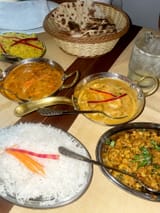>>214137694
It’s a misconception that Indian food always overwhelms with spice intensity. While chilies and masalas are important, many dishes—like Gujarati kadhi, Kashmiri yakhni, or South Indian rasam—rely on delicate seasoning and balance rather than sheer heat. The philosophy is not about masking flavors, but layering them, often in ways that highlight rather than suppress the core ingredients. Comparing this to French “clarity” or Japanese “restraint” misses the fact that Indian culinary aesthetics prize complexity and contrast instead.
Indian cooking encompasses far more than “stewing with onions and garlic.” Regional techniques include tandoor grilling (Punjab), steaming (idlis, dhoklas, pithas), shallow-frying (panjeeri, poha), roasting (bhartas, dry vegetable sabzis), slow-smoking (dum pukht), fermenting (dosas, pickles), and sun-drying (papads, vadis).
Rice and flatbreads are indeed staples, but so are lentils, chickpeas, kidney beans, pigeon peas, yogurt, paneer, fish, and goat. India is one of the few cuisines where vegetarian protein is deeply integrated and varied, from Bengal’s shorshe ilish (fish and mustard) to Punjab’s rajma-chawal.
A thali may not resemble a Japanese kaiseki meal, but it embodies an aesthetic of abundance, harmony, and balance—sweet, sour, bitter, pungent, salty, astringent—all in one spread. Regional presentations like banana-leaf meals in Kerala or the ornate Mughlai platters historically offered at royal courts also reflect care for presentation, just with different cultural priorities. Standardization in India is deliberately resisted; cooking is more artisanal, rooted in family tradition rather than codified “haute cuisine.”
Indian cuisine shouldn’t be judged by a narrow slice of restaurant curries abroad. Its true breadth reveals a system of culinary philosophy—layered spicing, grain-legume complementarity that reflects refinement of a different but equally valid kind.
 8/24/2025, 11:59:17 AM
No.214132291
>>214132343
>>214132523
>>214132548
>>214133946
>>214134119
>>214134510
>>214134574
>>214134724
>>214134957
>>214135008
>>214135127
>>214137396
>>214137568
>>214137727
>>214137962
>>214137983
>>214138030
>>214139841
8/24/2025, 11:59:17 AM
No.214132291
>>214132343
>>214132523
>>214132548
>>214133946
>>214134119
>>214134510
>>214134574
>>214134724
>>214134957
>>214135008
>>214135127
>>214137396
>>214137568
>>214137727
>>214137962
>>214137983
>>214138030
>>214139841






